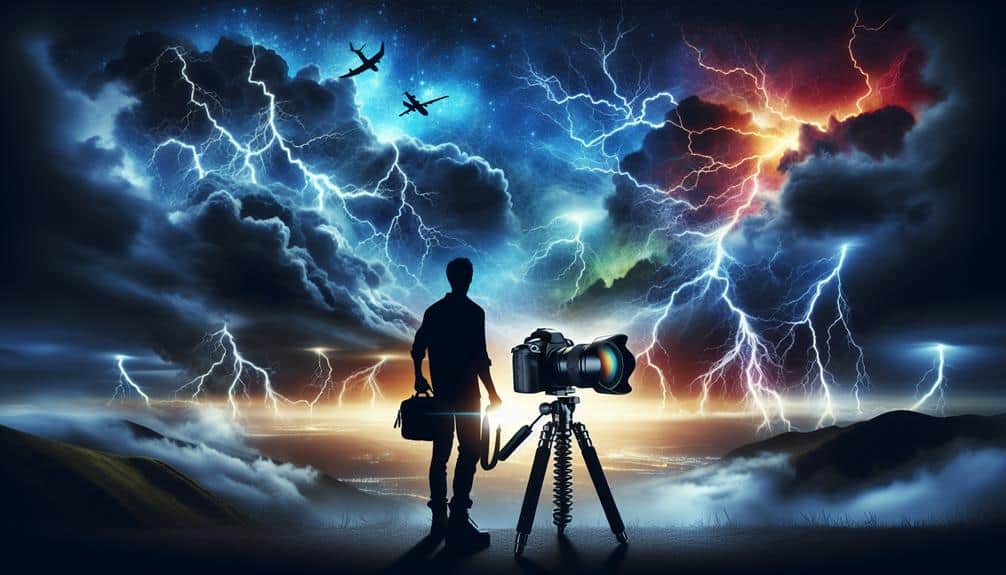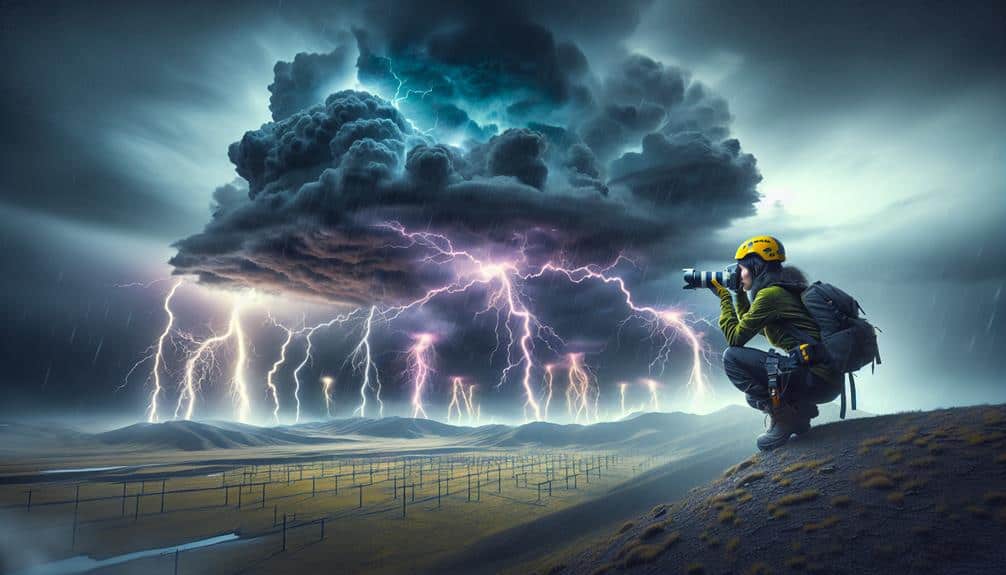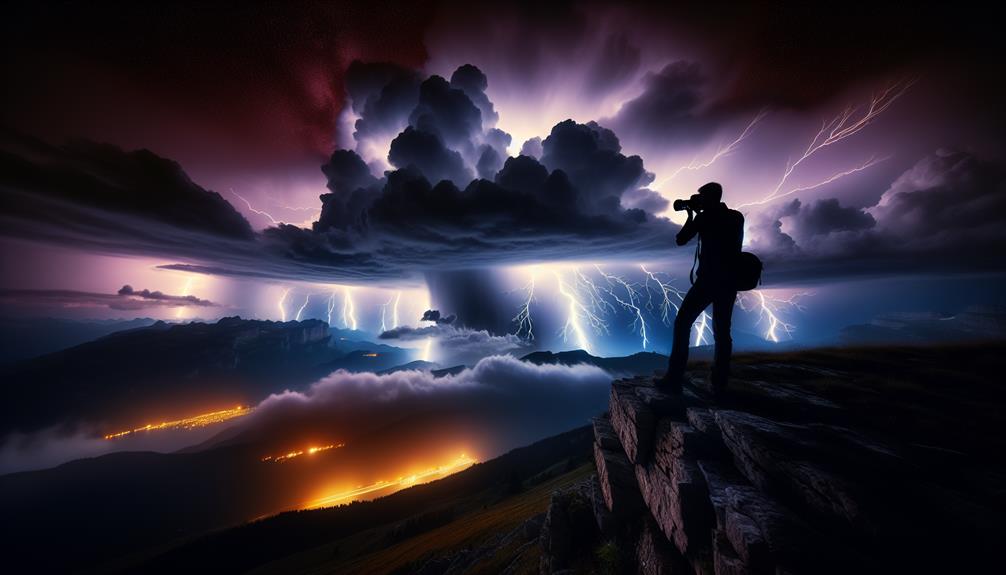When we capture lightning strikes, important equipment like a camera with manual setting and sturdy tripod is vital. Manual setting allows us to precisely control shutter speed and aperture, improving our chances of perfect shots. The tripod guarantees stability during long exposures, preventing blur. A wide-angle lens captures expansive storm scales, while a remote shutter release keeps images sharp. Lightning triggers help us capture strikes with precision, and weather protection gear guarantees our safety. Extra batteries and memory cards keep us prepared for extended sessions. This equipment collectively maximizes efficiency and creativity, revealing the full potential of lightning photography.
Key Points
- Ensures stability and clarity during long exposure shots, crucial for sharp lightning images.
- Allows precise control over exposure settings, optimizing the capture of lightning strikes.
- Prevents storage-related interruptions, facilitating continuous shooting and efficient workflow.
- Provides continuous power in remote locations, essential for extended photography sessions.
Camera With Manual Mode
One necessary instrument for capturing lightning strikes is a camera with manual mode, allowing us to control exposure settings precisely. When we're out in the field, the unpredictability of lightning demands we've full command over our camera settings. Manual mode grants us this freedom by letting us adjust the shutter speed, aperture, and ISO independently.
First, setting the shutter speed is pivotal. A longer exposure, typically between 10 to 30 seconds, increases our chances of capturing a strike. By keeping the shutter open longer, we can seize multiple flashes in a single frame without missing a beat.
Second, adjusting the aperture to around f/8 to f/11 provides a balanced depth of field and sharpness. This setting guarantees that the lightning's intricate branches are crisply rendered against the dark sky.
Lastly, managing ISO is essential for minimizing noise. A lower ISO, such as 100 or 200, maintains image clarity even during extended exposures.
Combining these elements gives us the precision and control needed to photograph lightning effectively.
Sturdy Tripod
A strong tripod is vital to maintaining the stability of our camera during long exposure shots, capturing the clearest possible images of lightning. When we're out scouting locations, setting up our tripod correctly becomes pivotal. Uneven or unstable ground can cause our camera to shake, resulting in blurred images. Using a tripod with adjustable legs and a dependable locking mechanism guarantees stability even on rugged terrain.
In terms of lighting techniques, the stability of a tripod allows us to experiment with various exposure settings without fretting about camera shake. This freedom lets us focus on perfecting our composition tips, such as framing the sky and foreground elements to create a balanced, compelling image.
Safety precautions are also crucial. A strong tripod ensures that our equipment remains secure during sudden gusts of wind or unexpected movements. It's vital to choose a model with a hook at the center column, allowing us to hang a weight for added stability.
Ultimately, a strong tripod isn't just a piece of equipment; it's a foundation for our creative freedom. By keeping our camera steady, we can concentrate on capturing the breathtaking power of lightning with precision and clarity.
Wide-Angle Lens
Selecting the right wide-angle lens allows us to capture the expansive scale and dramatic intensity of a lightning storm. By using a lens with a focal length between 10mm and 24mm, we make sure that our compositions can encompass the vastness of the sky and the striking details of each bolt. This range is ideal for experimenting with various composition techniques, such as the rule of thirds, to balance foreground elements with the electric spectacle above.
In challenging lighting conditions, wide-angle lenses excel by maximizing the available light, reducing noise in our images. They also enable us to capture the full arc of the storm, which is especially useful when the lightning is unpredictable. Post processing tips for wide-angle shots include correcting any lens distortion and enhancing the contrast to make the lightning stand out sharply against the dark clouds.
Creative angles can be explored by positioning the camera at unique vantage points, such as low to the ground to include foreground elements, or tilted skyward for a more dramatic effect. With a wide-angle lens, we gain the freedom to experiment and push the boundaries of lightning photography. Through careful planning and execution, our captures will evoke the awe-inspiring power of nature.
Remote Shutter Release
To complement our use of wide-angle lenses, employing a remote shutter release is crucial to achieving sharp, blur-free images during lightning storms. This tool allows us to capture stunning shots without physically touching the camera, which can introduce unwanted vibrations. For those of us who revel in creative freedom, the remote shutter release becomes essential.
When capturing lightning, we often rely on long exposures to seize the dramatic effect of multiple lightning bolts or the intricate patterns of a single strike. Holding down the shutter manually for extended periods is impractical and increases the risk of camera shake. By using a remote shutter release, we can maintain long exposures effortlessly, ensuring that our images remain crisp and clear.
Moreover, remote shutter releases enable us to experiment with creative angles. We can position our cameras in challenging locations—whether it's low to the ground for a dramatic upward perspective or perched on a cliff edge for a sweeping vista—without compromising stability. This freedom to explore unique viewpoints enhances the artistic quality of our lightning photographs, making each shot a tribute to both nature's fury and our technical prowess.
Lightning Trigger
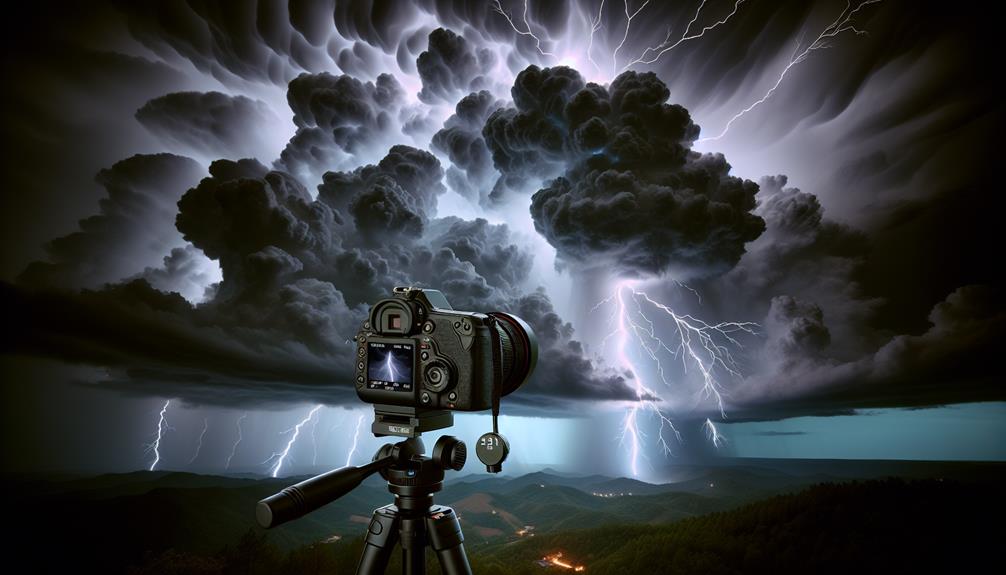
Lightning triggers are invaluable tools for capturing the precise moment a lightning bolt strikes, enhancing our ability to photograph these fleeting natural phenomena with precision. These devices detect the sudden change in light intensity when a bolt appears, instantly triggering the camera's shutter. This process requires impeccable timing accuracy and finely-tuned exposure settings.
To visualize how lightning triggers elevate our photography, consider these key aspects:
- Timing Accuracy: A lightning trigger ensures our camera reacts in milliseconds to capture the bolt's brilliance, something impossible to achieve manually.
- Exposure Settings: Using a lightning trigger allows us to focus on best exposure settings without worrying about missing the shot, balancing the dynamic range between the dark stormy sky and the bright lightning.
- Creative Opportunities: With the technical challenges of timing and exposure handled by the trigger, we can explore creative opportunities such as framing and composition, knowing our equipment will capture the perfect moment.
In essence, lightning triggers liberate us from the constraints of manual operation, offering both technical accuracy and creative freedom. By overcoming the inherent challenges in lightning photography, these devices make it possible to seize those electrifying moments with unparalleled accuracy.
Weather Protection Gear
When gearing up for lightning photography, we unquestionably need sturdy weather protection gear to shield our equipment from the unpredictable elements. A rain cover is indispensable; it guarantees our camera stays dry and functional even in torrential downpours. By fitting snugly over the camera body, it protects sensitive electronics without hindering usability.
A lens hood is another critical component. It not only reduces lens flare and enhances image quality but also offers physical protection against raindrops. This dual function is essential when we're aiming for that perfect lightning shot amidst stormy conditions.
Equally important is a waterproof bag. This isn't just for our camera; it keeps all our gear, including extra lenses and accessories, safe from water damage.
We should always pack a lens cloth as well. Rain and mist can settle on our lens, blurring our shots. A quick wipe with a lens cloth guarantees our images remain sharp and clear.
Extra Batteries and Memory Cards
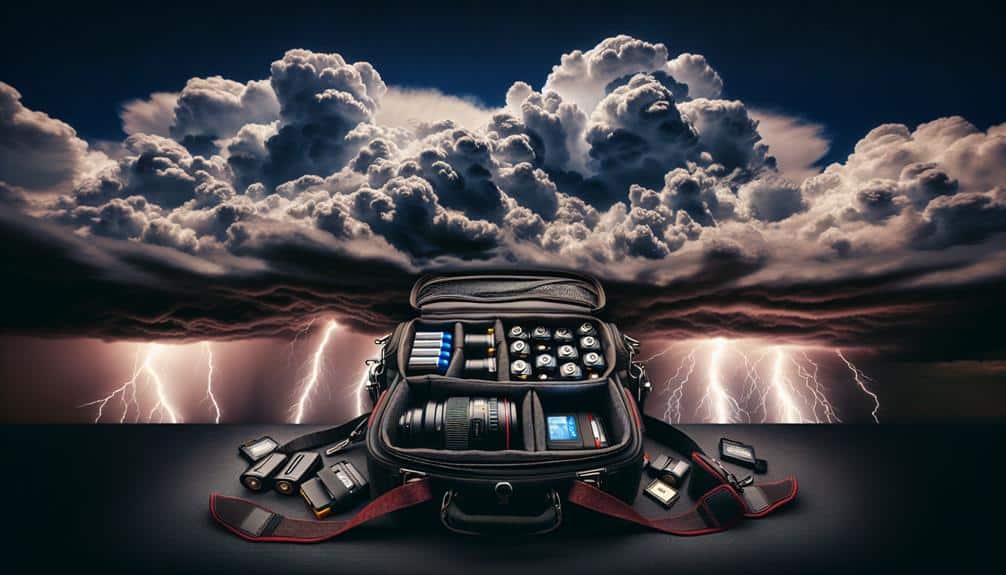
Given the unpredictable nature of storms, we must make certain we've extra batteries and memory cards to avoid interruptions during critical lightning photography moments. Capturing the perfect shot requires readiness and foresight. Here's why these essentials are non-negotiable:
1. Reliable Backup Plan:
Extra batteries guarantee that our camera doesn't die right when the sky puts on a show. Carrying multiple charged batteries provides a robust backup plan, allowing us to stay focused on capturing rather than conserving power.
2. Efficient Storage Solution:
Lightning photography can quickly fill up memory cards due to the rapid succession of shots. Extra memory cards serve as our storage solution, giving us the freedom to shoot continuously without worrying about running out of space.
3. Portable Charger and Data Transfer:
A portable charger keeps our gear powered up in remote locations, ensuring we don't miss any action. Additionally, having the means to transfer data on the go lets us clear and reuse memory cards, maintaining a seamless workflow.
Frequently Asked Questions
What Safety Precautions Should I Take While Photographing Lightning?
Capturing lightning is playing with fire, so let's prioritize safety tips: avoid open fields, stay in your car, and use a remote trigger. Proper equipment recommendations and timing strategies depend on constantly monitoring weather conditions.
How Do I Predict the Best Times for Lightning Storms?
We analyze weather patterns and forecast accuracy to predict lightning storms. By studying historical data and understanding lightning frequency, we can pinpoint best times. This approach balances technical expertise with the freedom to capture stunning shots safely.
Can Smartphone Cameras Capture High-Quality Lightning Photos?
We remember our first smartphone attempt—it felt like catching lightning in a bottle. Smartphone limitations hinder quality, but with professional equipment, lighting techniques, location scouting, and weather tracking, we capture the freedom and beauty of storms.
What Post-Processing Software Is Best for Enhancing Lightning Photos?
For enhancing lightning photos, we recommend using Lightroom editing for fine-tuning exposure and clarity, and Photoshop filters for adding dramatic effects. Both tools offer precise control, allowing us to create stunning, high-quality lightning images.
How Can I Find the Best Locations for Lightning Photography?
Don't worry about finding the perfect spot; we can nail it by combining location scouting and timing. Monitor weather conditions and make sure our equipment is ready. Research online maps and forums for proven lightning photography locations.
